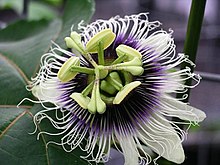Passion fruit (fruit)
The passion fruit (Portuguese: maracujá and Spanish: maracuyá, both from the Tupi mara kuya, lit. "fruit that serves itself" or "food in a cuia") and granadilla is the fruit of several plants in the genus Passiflora.[1][2] It is native to subtropical regions of South America from southern Brazil through Paraguay to northern Argentina.[1] The fruit is eaten for its pulp and seeds, and as a juice. The name passion fruit derives from 18th century Christian missionaries who interpreted the flower as a religious symbol.


Description
[edit]Passion fruits are round or oval, and range from a width of 1.5 to 3 inches (3.81 to 7.62 centimeters).[1] They can be yellow, red, purple, or green.[1]
Etymology
[edit]Maracujá
[edit]The Portuguese maracujá and Spanish maracuyá are both derived from the Tupi mara kuya "fruit that serves itself" or "food in a cuia".

Passion fruit
[edit]The term "passion fruit" in English comes from the passion flower, as an English translation of the Latin genus name, Passiflora, and may be spelled "passion fruit", "passionfruit", or "passion-fruit".[1][3] Around 1700, the name Passiflora was given by missionaries in Brazil as an educational aid to convert the Indigenous inhabitants to Christianity: its name was flor das cinco chagas or "flower of the Five Wounds" to illustrate the crucifixion of Christ and his resurrection, with other plant components also named after instruments of the Passion of Jesus.[3]
Varieties
[edit]Well-known edible passion fruits can be divided into four main types:[1]
- purple passion fruit (fruits of Passiflora edulis Sims),
- yellow passion fruit (Passiflora edulis f. flavicarpa Deg.),
- sweet granadilla (Passiflora ligularis),
- giant granadilla (Passiflora quadrangularis L.).
| Nutritional value per 100 g (3.5 oz) | |||||||||||||||||||||||||||||||||||||||||||
|---|---|---|---|---|---|---|---|---|---|---|---|---|---|---|---|---|---|---|---|---|---|---|---|---|---|---|---|---|---|---|---|---|---|---|---|---|---|---|---|---|---|---|---|
| Energy | 406 kJ (97 kcal) | ||||||||||||||||||||||||||||||||||||||||||
23.4 g | |||||||||||||||||||||||||||||||||||||||||||
| Sugars | 11.2 g | ||||||||||||||||||||||||||||||||||||||||||
| Dietary fiber | 10.4 g | ||||||||||||||||||||||||||||||||||||||||||
0.7 g | |||||||||||||||||||||||||||||||||||||||||||
2.2 g | |||||||||||||||||||||||||||||||||||||||||||
| |||||||||||||||||||||||||||||||||||||||||||
| Other constituents | Quantity | ||||||||||||||||||||||||||||||||||||||||||
| Water | 72.9 g | ||||||||||||||||||||||||||||||||||||||||||
| †Percentages estimated using US recommendations for adults,[4] except for potassium, which is estimated based on expert recommendation from the National Academies.[5] | |||||||||||||||||||||||||||||||||||||||||||
Uses
[edit]The fruits are mainly consumed and have a juicy edible center of many seeds.[1] The part of the fruit used (eaten) is the pulpy, juicy seeds. Passion fruits can also be squeezed to make juice.[1] It is also used in pastries and other baked products.
Composition
[edit]Nutrition
[edit]Raw passion fruit is 73% water, 23% carbohydrates, 2% protein, and 1% fat (table). In a reference amount of 100 g (3.5 oz), raw passion fruit supplies 97 calories and is a rich source of vitamin C (33% of the Daily Value, DV) and a moderate source of riboflavin and potassium (table). No other micronutrients are in significant content (table).
Phytochemicals
[edit]Several varieties of passion fruit are rich in polyphenols,[6][7] and some contain prunasin and other cyanogenic glycosides in the peel and juice.[8]
History
[edit]Passion fruit originates from South America, specifically from the region stretching from southern Brazil through Paraguay to northern Argentina. The fruit has been cultivated since ancient times, primarily by Indigenous communities in these areas. It was later introduced to Europe in 1553 by Spanish and Portuguese colonists.[9]
Gallery
[edit]-
Yellow passion fruit (Passiflora edulis f. flavicarpa)
-
Passiflora ligularis fruit
-
Red, yellow, and green Passiflora edulis
-
Giant granadilla (Passiflora quadrangularis L.)
-
Unripe common passion fruit
See also
[edit]References
[edit]- ^ a b c d e f g h Morton JF (1987). "Passionfruit, p. 320–328; In: Fruits of Warm Climates". NewCrop, Center for New Crops and Plant Products, Department of Horticulture and Landscape Architecture at Purdue University, W. Lafayette, Indiana. Retrieved 22 January 2020.
- ^ Dennis S. Hill (16 July 2008). Pests of Crops in Warmer Climates and Their Control. Springer Science & Business Media. pp. 605–. ISBN 978-1-4020-6738-9.
- ^ a b Davidson, Alan (2014). Passion-fruit; In: The Oxford Companion to Food (page 597; Ed. 3). Oxford University Press, Oxford, UK. ISBN 978-0191040726.
- ^ United States Food and Drug Administration (2024). "Daily Value on the Nutrition and Supplement Facts Labels". FDA. Archived from the original on 2024-03-27. Retrieved 2024-03-28.
- ^ National Academies of Sciences, Engineering, and Medicine; Health and Medicine Division; Food and Nutrition Board; Committee to Review the Dietary Reference Intakes for Sodium and Potassium (2019). "Chapter 4: Potassium: Dietary Reference Intakes for Adequacy". In Oria, Maria; Harrison, Meghan; Stallings, Virginia A. (eds.). Dietary Reference Intakes for Sodium and Potassium. The National Academies Collection: Reports funded by National Institutes of Health. Washington, DC: National Academies Press (US). pp. 120–121. doi:10.17226/25353. ISBN 978-0-309-48834-1. PMID 30844154. Retrieved 2024-12-05.
- ^ Talcott ST, Percival SS, Pittet-Moore J, Celoria C (2003). "Phytochemical composition and antioxidant stability of fortified yellow passion fruit (Passiflora edulis)". J Agric Food Chem. 51 (4): 935–41. Bibcode:2003JAFC...51..935T. doi:10.1021/jf020769q. PMID 12568552.
- ^ Devi Ramaiya S, Bujang JS, Zakaria MH, King WS, Shaffiq Sahrir MA (2013). "Sugars, ascorbic acid, total phenolic content and total antioxidant activity in passion fruit (Passiflora) cultivars". J Sci Food Agric. 93 (5): 1198–1205. Bibcode:2013JSFA...93.1198D. doi:10.1002/jsfa.5876. PMID 23027609.
- ^ Chassagne D, Crouzet JC, Bayonove CL, Baumes RL (1996). "Identification and Quantification of Passion Fruit Cyanogenic Glycosides". J Agric Food Chem. 44 (12): 3817–3820. Bibcode:1996JAFC...44.3817C. doi:10.1021/jf960381t.
- ^ "HS1406/HS1406: The Passion Fruit in Florida". edis.ifas.ufl.edu. Retrieved 2022-02-17.





